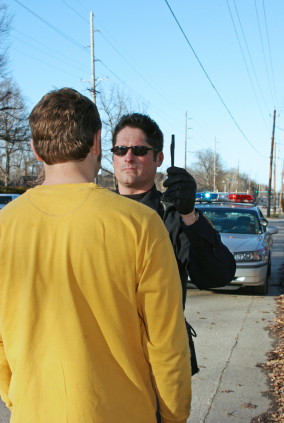
One of the field sobriety tests most commonly utilized by law enforcement in DUI investigations is the one-leg stand. This sobriety test was approved by the National Highway Traffic Safety Administration (NHTSA) as accurate and reliable in detecting drivers who are intoxicated on alcohol or drugs. The one-leg stand, also called one-legged stand or OLS, is employed by every police department in the state of Illinois.
Testing Conditions
The one-leg stand must be conducted with the driver standing outside the vehicle. There is no rule that says the police must conduct the OLS roadside. The police may, if they have probable cause to arrest, transport the driver to the police station and have him perform the test there, in the booking room. Police may also, under certain circumstances, transport the driver to another location such as a parking lot or gas station to perform testing (eg, under the canpoy of a gas station during stormy weather conditions).
The surface should be hard, dry and non-slippery. Also, the surrounding area must not endanger the driver if he were to fall during the test.
If the DUI stop occurs at night, the area should be illuminated. Even sober individuals would have difficulty balancing in total darkness.
The police officer is trained to observe the suspect’s performance from a distance, at least three feet away, so as to not distract the test subject.
The officer should ask about any injuries that would hamper the individual’s ability to stand on one leg. Injuries render the test inaccurate and unreliable and thus the officer should tell the suspect to use the other leg.
If the person has high heels or shoes with heels that are two inches tall, he or she should be allowed to take off the shoes and perform the test barefoot.
Instructions for the One-Legged Stand Test
The police officer should advise the suspect in the following manner:
Please stand with your heels together and your arms down at your sides, like this.
The officer should assume that position for the driver to see.
When I tell you to, I want you to raise one leg about six inches off the ground and hold that position. At the same time, count rapidly from 1001 to 1030 while watching your foot.
The policeman should then demonstrate. The toes of the raised foot should point towards the sky while counting 1001, 1002, 1003 and 1004. The officer need not count all the way to 1030.
Do you understand?
If the motorist has questions, he may ask, but the police officer is not required to answer all questions. In fact, an inability to understand the directions will be used against the motorist as an indication of impairment.
How to Pass One-Leg Stand
Whether the driver passes the OLS is determined by a scoring system. The score is based on five components. The driver will be assigned (more like deducted) one point for each component. Only one point is assigned for each component, for a maximum of five points against the driver.
- Swaying while balancing. If the driver sways side-to-side or back-and-forth while standing, the officer gives him one point.
- Using arms for balance. The police officer will assign the driver one point for raise his or her arms more than six inches from the leg at any given time.
- Hopping on one foot. If the suspect hops on one foot in order to maintain balance, this counts as one point.
- Puts foot down. If the driver puts his foot down one or more times during the 30-second count, the police officer will assign one point.
- Cannot do test. Putting one’s foot down three times or more during the test indicates the driver cannot perform the test, and this counts as one point.
Police officers will often testify at trial that the driver showed other clues of impairment, such as counting improperly (eg, skipping numbers) or failing to hold the foot at least six inches above the ground. These are not counted as reasons the driver may be intoxicated, however.
Reasons People Fail the One-Legged Stand
The OLS is a test many people would fail even while sober. Police officers are taught this during their training, but may refuse to acknowledge it when questioned in court.
People who are 60 years of age or older have poor balance and will fail the test. Likewise, people who are 50 pounds or more overweight will also fail the test due to poor balance.
Because nearly 90 percent of DUI arrests take place at night, the darkness can be a factor. The police officer is trained to shine his flashlight on the ground near the suspect’s feet for illumination, but often the bright spot will jiggle and disorient the test subject.
Counting 30 Seconds
The counting towards 30 seconds is problematic because each person may count at a different speed. The test presumes that a drunk person cannot balance for more than 25 seconds. But if the driver counts slowly, then he may get to 30 seconds but only say 20-25.
Likewise, skipping or repeating a number is talked about as though it shows the driver is drunk, but the testing procedures do not indicate that this is a point counting against him.

